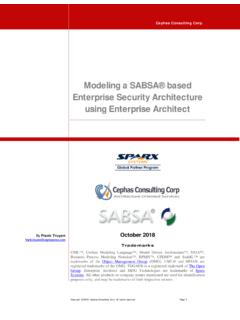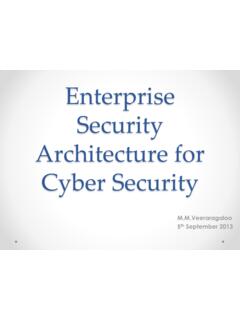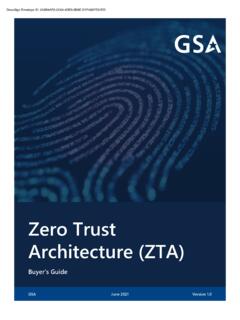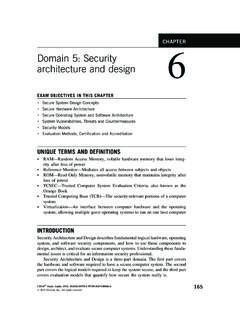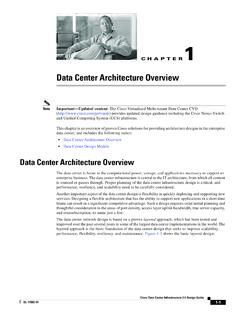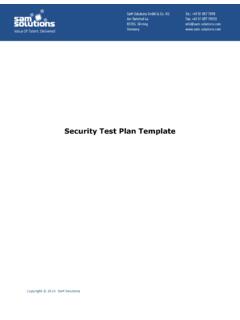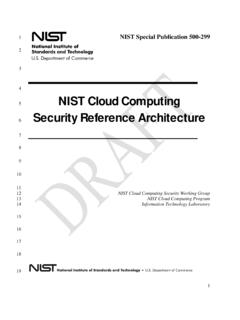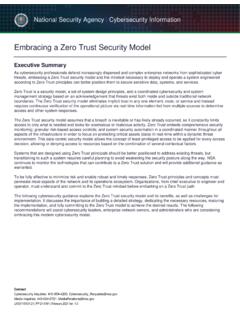Transcription of Information Security: Principles and Practices
1 Information security : Principles and Practices Second Edition Mark S. Merkow Jim Breithaupt 800 East 96th Street, Indianapolis, Indiana 46240 USA. Information security : Principles and Practices , Second Associate Publisher Edition Dave Dusthimer Copyright 2014 by Pearson Education, Inc. Acquisitions Editor Betsy Brown All rights reserved. No part of this book shall be reproduced, stored in a retrieval system, or transmitted by any means, electronic, mechanical, photocopying, recording, or otherwise, Development Editor without written permission from the publisher. No patent liability is assumed with respect Jeff Riley to the use of the Information contained herein. Although every precaution has been taken in the preparation of this book, the publisher and author assume no responsibility for errors or Managing Editor omissions. Nor is any liability assumed for damages resulting from the use of the Information Sandra Schroeder contained herein.
2 Senior Project Editor ISBN-13: 978-0-7897-5325-0. Tonya Simpson ISBN-10: 0-7897-5325-1. Library of Congress Control Number: 2014937271 Copy Editor Krista Hansing Editorial Printed in the United States of America Services, Inc. First Printing: June 2014. Indexer Publishing Works Trademarks All terms mentioned in this book that are known to be trademarks or service marks have Proofreader been appropriately capitalized. Pearson IT Certification cannot attest to the accuracy of this Paula Lowell Information . Use of a term in this book should not be regarded as affecting the validity of any trademark or service mark. Technical Editors Tatyana Zidarov Chris Crayton Warning and Disclaimer Every effort has been made to make this book as complete and as accurate as possible, but no Publishing Coordinator warranty or fitness is implied. The Information provided is on an as is basis. The authors Vanessa Evans and the publisher shall have neither liability nor responsibility to any person or entity with respect to any loss or damages arising from the Information contained in this book.
3 Cover Designer Alan Clements Special Sales Compositor For Information about buying this title in bulk quantities, or for special sales opportunities Trina Wurst (which may include electronic versions; custom cover designs; and content particular to your business, training goals, marketing focus, or branding interests), please contact our corporate sales department at or (800) 382-3419. For government sales inquiries, please contact For questions about sales outside the , please contact Contents at a Glance Preface .. xiii 1 Why Study Information security ?..2. 2 Information security Principles of 3 Certification Programs and the Common Body of Knowledge ..36. 4 Governance and Risk Management ..54. 5 security Architecture and Design ..80. 6 Business Continuity Planning and Disaster Recovery Planning ..110. 7 Law, Investigations, and Ethics ..126. 8 Physical security Control ..146. 9 Operations security .
4 166. 10 Access Control Systems and Methodology ..182. 11 Cryptography ..200. 12 Telecommunications, Network, and Internet security ..224. 13 Software Development security ..260. 14 Securing the Future ..280. A Common Body of Knowledge ..292. B security Policy and Standards Taxonomy ..302. C Sample Policies ..306. D HIPAA security Rule Index ..324. iii Table of Contents Preface xiii Chapter 1: Why Study Information security ? 2. Introduction .. 2. The Growing Importance of IT security and New Career Opportunities .. 3. An Increase in Demand by Government and Private Industry.. 4. Becoming an Information security Specialist .. 4. Schools Are Responding to Demands.. 6. The Importance of a Multidisciplinary Approach .. 7. Contextualizing Information security .. 7. Information security Careers Meet the Needs of Business .. 8. Summary .. 11. Test Your Skills .. 11. Chapter 2: Information security Principles of Success 18.
5 Introduction .. 18. Principle 1: There Is No Such Thing As Absolute security .. 19. Principle 2: The Three security Goals Are Confidentiality, Integrity, and Availability .. 20. Integrity Models .. 21. Availability Models .. 21. Principle 3: Defense in Depth as Strategy .. 22. Principle 4: When Left on Their Own, People Tend to Make the Worst security Decisions .. 24. Principle 5: Computer security Depends on Two Types of Requirements: Functional and Assurance .. 24. Principle 6: security Through Obscurity Is Not an Answer .. 25. Principle 7: security = Risk Management .. 25. Principle 8: The Three Types of security Controls Are Preventative, Detective, and Responsive .. 27. Principle 9: Complexity Is the Enemy of security .. 29. Principle 10: Fear, Uncertainty, and Doubt Do Not Work in Selling security . 29. Principle 11: People, Process, and Technology Are All Needed to Adequately Secure a System or Facility.
6 29. iv Table of Contents Principle 12: Open Disclosure of Vulnerabilities Is Good for security ! .. 30. Summary .. 31. Test Your Skills .. 31. Chapter 3: Certification Programs and the Common Body of Knowledge 36. Introduction .. 36. Certification and Information security .. 37. International Information Systems security Certifications Consortium (ISC)2 .. 38. The Information security Common Body of Knowledge.. 39. Information security Governance and Risk Management .. 39. security Architecture and Design .. 40. Business Continuity and Disaster Recovery Planning .. 40. Legal Regulations, Investigations, and Compliance.. 41. Physical (Environmental) security .. 41. Operations security .. 42. Access Control .. 42. Cryptography .. 42. Telecommunications and Network security .. 43. Software Development security .. 43. Other Certificate Programs in the IT security Industry .. 44. Certified Information Systems Auditor.
7 44. Certified Information security Manager.. 44. Certified in Risk and Information Systems Control .. 44. Global Information Assurance Certifications.. 44. (ISC)2 Specialization Certificates .. 45. CCFP: Certified Cyber Forensics Professional .. 45. HCISPP: HealthCare Information security and Privacy Practitioner .. 45. Vendor-Specific and Other Certification Programs .. 46. Summary .. 47. Test Your Skills .. 47. Chapter 4: Governance and Risk Management 54. Introduction .. 54. security Policies Set the Stage for Success .. 55. Understanding the Four Types of Policies .. 57. Table of Contents v Programme-Level Policies .. 57. Programme-Framework Policies .. 59. Issue-Specific Policies .. 60. System-Specific Policies .. 61. Developing and Managing security Policies .. 62. security Objectives .. 62. Operational security .. 62. Policy Implementation.. 63. Providing Policy Support Documents .. 64. Regulations.
8 64. Standards and Baselines .. 66. Guidelines .. 67. Procedures .. 67. Suggested Standards Taxonomy .. 67. Asset and Data Classification.. 67. Separation of Duties .. 68. Employment Hiring Practices .. 69. Risk Analysis and Management .. 70. Education, Training, and Awareness .. 72. Who Is Responsible for security ? .. 73. Summary .. 74. Test Your Skills .. 74. Chapter 5: security Architecture and Design 80. Introduction .. 80. Defining the Trusted Computing Base .. 81. Rings of Trust .. 81. Protection Mechanisms in a TCB .. 84. System security Assurance Concepts .. 86. Goals of security Testing .. 86. Formal security Testing Models .. 87. The Trusted Computer security Evaluation Criteria .. 87. Division D: Minimal Protection .. 88. Division C: Discretionary Protection .. 88. vi Table of Contents Division B: Mandatory Protection .. 88. Division A: Verified Protection .. 90. The Trusted Network Interpretation of the TCSEC.
9 91. The Information Technology security Evaluation Criteria .. 91. Comparing ITSEC to TCSEC .. 91. ITSEC Assurance Classes .. 92. The Canadian Trusted Computer Product Evaluation Criteria .. 93. The Federal Criteria for Information Technology security .. 93. The Common Criteria .. 94. Protection Profile Organization.. 95. security Functional Requirements .. 96. Evaluation Assurance Levels .. 98. The Common Evaluation Methodology .. 100. Confidentiality and Integrity Models .. 101. Bell-LaPadula Model .. 101. Biba Integrity Model .. 102. Advanced Models .. 102. Summary .. 104. Test Your Skills .. 104. Chapter 6: Business Continuity Planning and Disaster Recovery Planning 110. Introduction .. 110. Overview of the Business Continuity Plan and Disaster Recovery Plan .. 111. Why the BCP Is So Important .. 112. Types of Disruptive Events .. 113. Defining the Scope of the BCP .. 114. Creating the Business Impact Analysis.
10 114. Disaster Recovery Planning .. 115. Identifying Recovery Strategies .. 116. Understanding Shared-Site Agreements.. 116. Using Alternate Sites .. 116. Making Additional Arrangements .. 117. Testing the DRP .. 118. Table of Contents vii Summary .. 120. Test Your Skills .. 120. Chapter 7: Law, Investigations, and Ethics 126. Introduction .. 126. Types of Computer Crime .. 127. How Cybercriminals Commit Crimes .. 128. The Computer and the Law .. 129. Legislative Branch of the Legal System .. 130. Administrative Branch of the Legal System .. 130. Judicial Branch of the Legal System .. 130. Intellectual Property Law .. 131. Patent Law .. 131. Trademarks .. 132. Trade Secrets .. 132. Privacy and the Law .. 133. International Privacy Issues .. 133. Privacy Laws in the United States .. 134. Computer Forensics .. 135. The Information security Professional's Code of Ethics .. 136. Other Ethics Standards.










